Reviews
Stanley Kubrick
USA, 1956
Credits
Review by Evan Kindley
Posted on 04 March 2010
Source MGM/UA DVD
Categories Kubrick
Often branded a film noir, Kubrick’s third movie is a lot less about atmosphere than it is about set-up: the molecular, painstaking labor needed to bring off a successful - or even an unsuccessful - operation. Where later Kubrick films are notable for their exploration of enormous, often mysterious edifices (militaries, monoliths, haunted hotels, secret societies), The Killing focuses relentlessly on the little stuff, the nooks and crannies, rather than the grand achievement itself. It’s a movie about the pleasures and frustrations of planning and execution (in both senses of the word).
The Killing follows a plot masterminded by one Johnny Clay, a career criminal recently released from Alcatraz, to rob a racetrack of its daily take. While Sterling Hayden (who would work with Kubrick again on Dr. Strangelove) enjoys marquee status as Johnny, he doesn’t get significantly more screen time than his co-stars, and the film has no real protagonist. Nor is it really an ensemble piece, a term which would seem to imply a bit more cohesion among the principals than we get in Kubrick’s film. Instead, the characters are mostly isolated agents unaware of one another’s actions or sometimes even existence, their activities linked together only by Johnny’s scheme and by the flat reportage of an omniscient narrator. The Killing’s half-hour-long first act underlines the equality of its players by juxtaposing formally very similar scenes of men and women talking over what is shortly to come. In one scene after another, we watch the male conspirators - Johnny, window teller George Peatty, track bartender Mike O’Reilly, crooked cop Randy Kennan - preparing their loved ones for a big score, displaying varying levels of finesse when it comes to keeping the details of the plot on a need-to-know basis. (Notably incompetent is George, who spills the beans to his scheming wife Sherry, played by scenery-chewing “Queen of the Bs” Marie Windsor.) These early scenes are where the dialogue by hard-boiled novelist Jim Thompson, Kubrick’s collaborator on the script, is most pungent, and the noir quality the most pronounced: the low angles, sharp shadows, and long takes make them seem like they’re all happening in one cramped apartment, creating a sense of unity that will soon be exploded by the ramifications that follow.
The conspiracy widens out in the ensuing scenes, as the real complexity of the heist plot, which involves a series of diversions from the robbery timed to occur at the exact same time, becomes clearer. Kubrick creates a strong sense of contrast here, shifting from the claustrophobic framings of the early scenes to a variety of more dynamic locales (a chess and checkers club, a shooting range, a sleazy motel). The director’s education in journalism and documentary is apparent, but so is the meticulous sense of place that would ultimately lead him to reconstruct New York streets on London soundstages for Eyes Wide Shut decades later. The central racetrack heist sequence, in particular, feels like an aesthetic crossroads, branching out in two divergent directions simultaneously, as Kubrick cuts together handheld location footage with an intricate interior set. Kubrick’s challenge - to make the heist feel real, but at the same time to choreograph it as closely as possible - is also Johnny’s, and the movie benefits from the feeling of being on the verge of disorder.
Similarly, the performances in The Killing are far less uniform and controlled than they tend to be in Kubrick’s later work. The film is loaded with feisty 50s character actors - from Elisha Cook, Jr. as the increasingly squirrelly George Peatty to Tim Carey as the teeth-clenching, puppy-stroking hired assassin Nikki Arcane - all of whom project a powerful sense of unpredictability and untrustworthiness. Kubrick’s camera stops for each one, dutifully taking their measure and giving them their moment—so much so that you might think he’s only indulging them, or getting distracted by their oddity. But these small turns are important for the film on a structural level as well, since the theme of The Killing as a whole is the difficulty of accounting for individual behavior. Thus we get more interest in human psychology here than one normally associates with Kubrick, though what finally interests him most is the way psychology thwarts collective action: a casual racial slur, a case of jealousy or nerves, can bring even the most intricately directed production to a halt. If his monumental later films tend to suggest an immense conspiracy or a hostile cosmos dwarfing human beings and their individual projects, The Killing is a humbler study of Murphy’s Law and of human nature: here, it’s the people who get in the conspiracy’s way.
The Killing’s final sequence is perhaps its most famous, and while I wouldn’t want to spoil it for those who haven’t yet had the pleasure, let’s just say it ranks as one of the most humorous and playful moments in the director’s filmography. (All right, three words: canis ex machina.) In context, though, it’s a little puzzling, and the general tone of The Killing is actually quite difficult to characterize. While its tricky temporal switchbacks and elaborate but whimsical plotting surely influenced the likes of Quentin Tarantino (the shopping mall sequence in Jackie Brown, for instance, is an obvious homage), it shows none of the warmth and sympathy toward its criminal characters that Tarantino or Scorsese regularly exhibit. But neither does it moralize or hammer home the message that “crime doesn’t pay” to the extent that one might expect from a 1950s caper flick. And while this lack of moralism was typical of Thompson in particular and contemporary noir generally, The Killing’s final acts are far too frantic to qualify for the cooled-out world of your everyday noir. This is because Kubrick doesn’t care about the morality of his character’s actions, and neither does he find their lifestyle seductive: his interest in the material is in its complexity, and as soon as the plan crumbles he loses all interest or investment in the participants.
One scene does suggest a slight stake in the proceedings: this is Johnny visiting the Russian wrestler Maurice, played by Kubrick’s old friend Kola Kwariani, in a New York chess club modeled on one the director himself frequented as a youth. In an often-quoted speech, delivered apropos of nothing in particular, Maurice says: “You know, I’ve often thought that the gangster and the artist are the same in the eyes of the masses. They are admired and hero-worshipped. But there is always present an underlying wish to see them destroyed at the peak of their glory.” Certainly gangsters as ambitious and clever as Johnny have something in common with artists, or anyway filmmakers: they’re trying to coordinate activity on a vast scale, and here Kubrick suggests that the public enjoys watching them fail as much as it does seeing them succeed. But I don’t think Kubrick thinks these people are artists, though perhaps he thinks what they do is something a real artist could or should be able to do, on top of everything else. But what separates someone like Johnny or George from a real artist is that they’re motivated solely by money—they only want to “make a killing,” not produce anything lasting. So perhaps the young Kubrick is making an early, private judgment on Hollywood itself, with its enormous practical machinery and underbelly of desperate characters looking to make a big score. Perhaps that’s why, beyond the façade of cool detachment, you can sense a certain glee when it all goes wrong.
More Kubrick
-
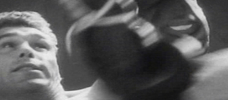
Stanley Kubrick’s Early Documentaries
1951-53 -
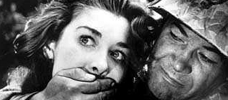
Fear and Desire
1953 -
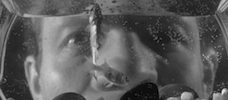
Killer’s Kiss
1955 -
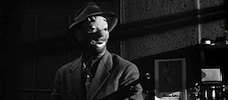
The Killing
1956 -
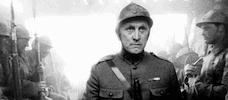
Paths of Glory
1957 -
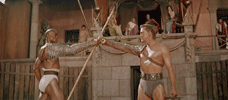
Spartacus
1960 -

Lolita
1962 -
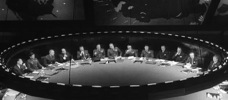
Dr. Strangelove or: How I Learned to Stop Worrying and Love the Bomb
1964 -

2001: A Space Odyssey
1968 -
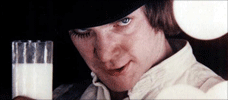
A Clockwork Orange
1971 -
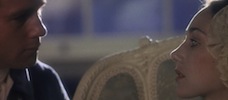
Barry Lyndon
1975 -
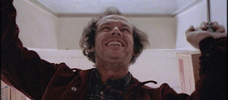
The Shining
1980 -

Full Metal Jacket
1987 -
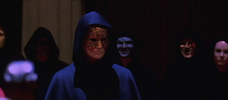
Eyes Wide Shut
1999 -

A.I.
2001
We don’t do comments anymore, but you may contact us here or find us on Twitter or Facebook.



